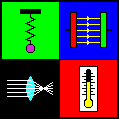
The processes of natural radioactivity can be divided into three types:
For heavy nuclei it often occurs that the daughter nuclei, which have been formed by radioactive decay, decay again to form new daughter nuclei and so on, until finally, after many decay processes, a stable nucleus is left. In this case, we use the term decay series or decay chain. Now, the mass number decreases by 4 or remains constant at any decay. If we divide the mass numbers for the nuclides of the same decay series by 4, the remainder will always be the same (0, 1, 2 or 3). That's why there are four decay series. One of them however (the Neptunium series) contains only synthetic nuclides.
This Java applet shows a small part of the table of nuclids in which short notations like Th 232 (consisting of the chemical symbol and the mass number) are used for reasons of space. The number of protons is indicated at the left, the number of neutrons at the beginning of a column. Yellow color is used for alpha decay, blue color for beta decay. After you have chosen one of the decay series in the selection field on the bottom left, you can see by repeated mouse clicks on the green button ("Next decay") which nuclei are formed one after the other.

|
| Physics Applets |
URL: http://www.walter-fendt.de/ph14e/decayseries.htm
© Walter Fendt, July 20, 1998
Last modification: February 7, 2010